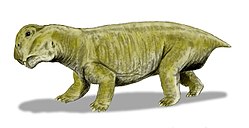| Digalodon Temporal range: Cistecephalus Assemblage Zone? | |
|---|---|
| Scientific classification | |
| Domain: | Eukaryota |
| Kingdom: | Animalia |
| Phylum: | Chordata |
| Clade: | Synapsida |
| Clade: | Therapsida |
| Suborder: | † Anomodontia |
| Clade: | † Dicynodontia |
| Genus: | † Digalodon Broom & Robinson, 1948 |
| Species: | †D. rubidgei |
| Binomial name | |
| †Digalodon rubidgei Broom and Robinson, 1948 | |
Digalodon is an extinct genus of kistecephalian dicynodont, known from the Karoo Basin of South Africa and the Upper Madumabisa Mudstone Formation of Zambia. [1] Originally given a sparse description in 1948, [2] for a time it was considered synonymous with other dicynodonts as a small juvenile individual of a larger genus, such as Aulacephalodon [3] or Dicynodontoides ; [4] however it has since been recognized as a distinct species. [5]





